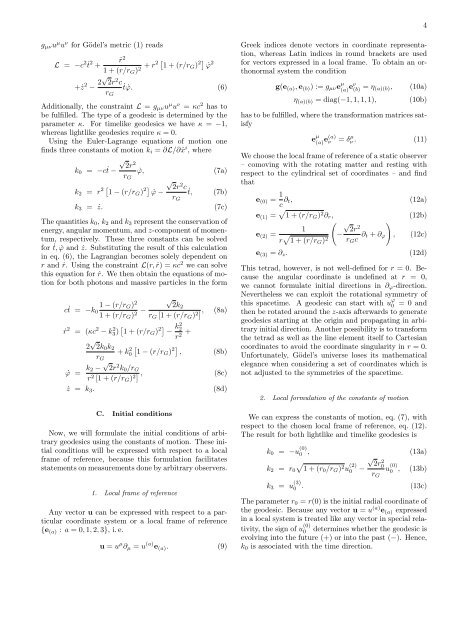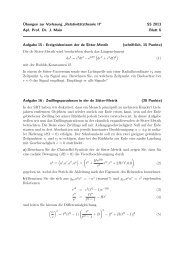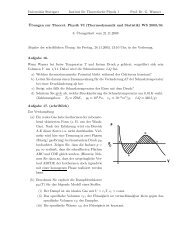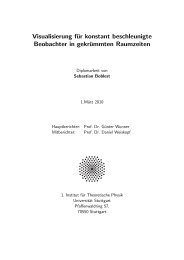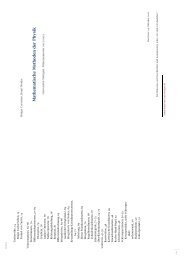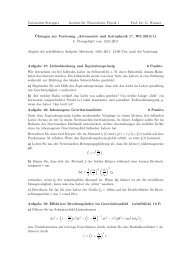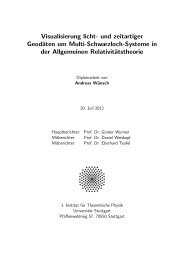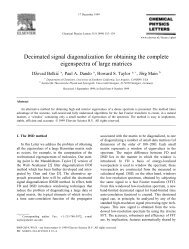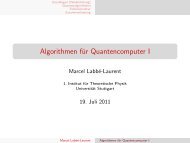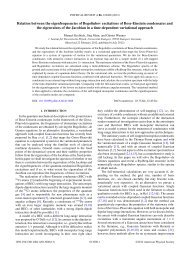The Gödel universe - Institut für Theoretische Physik der Universität ...
The Gödel universe - Institut für Theoretische Physik der Universität ...
The Gödel universe - Institut für Theoretische Physik der Universität ...
Create successful ePaper yourself
Turn your PDF publications into a flip-book with our unique Google optimized e-Paper software.
gµνu µ u ν for <strong>Gödel</strong>’s metric (1) reads<br />
L = −c 2 ˙t 2 +<br />
˙r 2<br />
1 + (r/rG) 2 + r2 1 + (r/rG) 2 ˙ϕ 2<br />
+ ˙z 2 − 2√2r2c ˙t ˙ϕ. (6)<br />
rG<br />
Additionally, the constraint L = gµνu µ uν = κc2 has to<br />
be fulfilled. <strong>The</strong> type of a geodesic is determined by the<br />
parameter κ. For timelike geodesics we have κ = −1,<br />
whereas lightlike geodesics require κ = 0.<br />
Using the Euler-Lagrange equations of motion one<br />
finds three constants of motion ki = ∂L/∂ ˙x i , where<br />
√<br />
2 2r<br />
k0 = −c˙t − ˙ϕ, (7a)<br />
rG<br />
k2 = r 2 1 − (r/rG) 2 √<br />
2 2r c<br />
˙ϕ − ˙t, (7b)<br />
rG<br />
k3 = ˙z. (7c)<br />
<strong>The</strong> quantities k0, k2 and k3 represent the conservation of<br />
energy, angular momentum, and z-component of momentum,<br />
respectively. <strong>The</strong>se three constants can be solved<br />
for ˙t, ˙ϕ and ˙z. Substituting the result of this calculation<br />
in eq. (6), the Lagrangian becomes solely dependent on<br />
r and ˙r. Using the constraint L(r, ˙r) = κc 2 we can solve<br />
this equation for ˙r. We then obtain the equations of motion<br />
for both photons and massive particles in the form<br />
1 − (r/rG)<br />
c˙t = −k0<br />
2<br />
√<br />
2k2<br />
−<br />
1 + (r/rG) 2<br />
rG [1 + (r/rG) 2 , (8a)<br />
]<br />
˙r 2 = (κc 2 − k 2 3) 1 + (r/rG) 2 − k2 2<br />
+<br />
r2 2 √ 2k0k2<br />
+ k 2 <br />
0 1 − (r/rG) 2 , (8b)<br />
rG<br />
˙ϕ = k2 − √ 2r2k0/rG , (8c)<br />
r 2 [1 + (r/rG) 2 ]<br />
˙z = k3. (8d)<br />
C. Initial conditions<br />
Now, we will formulate the initial conditions of arbitrary<br />
geodesics using the constants of motion. <strong>The</strong>se initial<br />
conditions will be expressed with respect to a local<br />
frame of reference, because this formulation facilitates<br />
statements on measurements done by arbitrary observers.<br />
1. Local frame of reference<br />
Any vector u can be expressed with respect to a particular<br />
coordinate system or a local frame of reference<br />
{e (a) : a = 0,1,2,3}, i.e.<br />
u = u µ ∂µ = u (a) e (a). (9)<br />
Greek indices denote vectors in coordinate representation,<br />
whereas Latin indices in round brackets are used<br />
for vectors expressed in a local frame. To obtain an orthonormal<br />
system the condition<br />
g(e (a),e (b)) := gµνe µ<br />
(a) eν (b) = η (a)(b), (10a)<br />
η (a)(b) = diag(−1,1,1,1), (10b)<br />
has to be fulfilled, where the transformation matrices satisfy<br />
4<br />
e µ<br />
(a) e(a)<br />
ν = δ µ ν . (11)<br />
We choose the local frame of reference of a static observer<br />
– comoving with the rotating matter and resting with<br />
respect to the cylindrical set of coordinates – and find<br />
that<br />
e (0) = 1<br />
c ∂t, (12a)<br />
e (1) = 1 + (r/rG) 2∂r, (12b)<br />
1<br />
e (2) =<br />
r 1 + (r/rG) 2<br />
√<br />
2 2r<br />
−<br />
rGc ∂t<br />
<br />
+ ∂ϕ , (12c)<br />
e (3) = ∂z. (12d)<br />
This tetrad, however, is not well-defined for r = 0. Because<br />
the angular coordinate is undefined at r = 0,<br />
we cannot formulate initial directions in ∂ϕ-direction.<br />
Nevertheless we can exploit the rotational symmetry of<br />
this spacetime. A geodesic can start with u ϕ<br />
0<br />
= 0 and<br />
then be rotated around the z-axis afterwards to generate<br />
geodesics starting at the origin and propagating in arbitrary<br />
initial direction. Another possibility is to transform<br />
the tetrad as well as the line element itself to Cartesian<br />
coordinates to avoid the coordinate singularity in r = 0.<br />
Unfortunately, <strong>Gödel</strong>’s <strong>universe</strong> loses its mathematical<br />
elegance when consi<strong>der</strong>ing a set of coordinates which is<br />
not adjusted to the symmetries of the spacetime.<br />
2. Local formulation of the constants of motion<br />
We can express the constants of motion, eq. (7), with<br />
respect to the chosen local frame of reference, eq. (12).<br />
<strong>The</strong> result for both lightlike and timelike geodesics is<br />
, (13a)<br />
√<br />
2 2r0 k0 = −u (0)<br />
0<br />
<br />
k2 = r0 1 + (r0/rG) 2u (2)<br />
0 −<br />
rG<br />
u (0)<br />
0 , (13b)<br />
k3 = u (3)<br />
0 . (13c)<br />
<strong>The</strong> parameter r0 = r(0) is the initial radial coordinate of<br />
the geodesic. Because any vector u = u (a) e (a) expressed<br />
in a local system is treated like any vector in special relativity,<br />
the sign of u (0)<br />
0 determines whether the geodesic is<br />
evolving into the future (+) or into the past (−). Hence,<br />
k0 is associated with the time direction.


